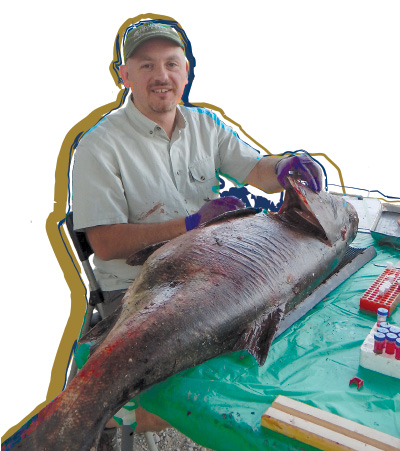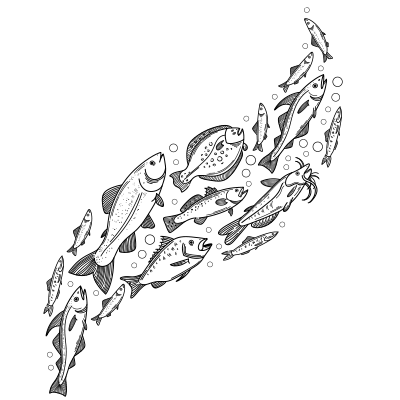

By Emily Lenhard
Bartolomeo Gorgoglione, DVM, MSc, PhD, CertAqV, is an internationally recognized scientist who leads the Fish Pathobiology and Immunology Laboratory at the Michigan State University College of Veterinary Medicine. Gorgoglione holds the honorific title of certified aquatic veterinarian, and is a trusted collaborator of the European Association of Fish Pathologists, an entity dedicated to the promotion and exchange of knowledge on and assistance in fish and shellfish pathology research.
 Dr. Bartolomeo Gorgoglione sampling organs of an invasive silver carp caught from the Illinois River in Illinois.
Dr. Bartolomeo Gorgoglione sampling organs of an invasive silver carp caught from the Illinois River in Illinois.
The animal world is full of complex pathogen interactions and emerging diseases, and fish hosts are no exception. Gorgoglione’s research broadly applies to fish virology and parasitology, with emphasis on polymicrobial infections affecting wild and farmed fish species.
The bulk of Gorgoglione’s recent work focuses on discovering threats at home and abroad. His research group has detected a new parasite in the Great Lakes Basin, including in migratory salmonids from Lakes Michigan and Huron. Tetracapsuloides bryosalmonae is listed as an emergency fish pathogen by the Great Lakes Fishery Commission, and is included in the Michigan Reportable Animal Disease List by the Michigan Department of Agriculture and Rural Development. Gorgoglione says T. bryosalmonae is known to cause proliferative kidney disease in susceptible salmonid species in Europe and the western United States. Previously, he discovered its occurrence in Austria and, more recently, documented its movement northward by infecting Pacific Salmon in Alaska.
“This myxozoan parasite might already be well established in the Great Lakes ecosystems, and local salmonids may be tolerant to the infection.” Gorgoglione explains this may change how fisheries and aquaculture regulators respond. “I’m suggesting there’s no need to depopulate any hatchery because the pathogen is already in the environment, in the main lakes and inland water bodies. An affected hatchery won’t change anything about what’s already in nature, and instead, may provide natural immunization to juvenile fish.”
Gorgoglione is also focused on koi herpesvirus (KHV) and carp edema virus (CEV), and his research isn’t geographically limited. In partnership with Israeli collaborators, Gorgoglione’s PhD student, Santosh Lamichhane, is investigating immunological mechanisms that may enable common and Asian carp species to resist KHV infection. This research is important in defining the role of native fish and of North America’s invasive Asian carp species in spreading KHV and CEV.
“These are not emergency pathogens, but they’re monitored in Michigan and considered as notifiable [KHV] or emerging [CEV] diseases by the World Organisation for Animal Health,” shares Gorgoglione. “CEV is the largest virus infecting any vertebrate animal. In the past decade, it has been found in carps and koi all around the world.”
With other international collaborators, Gorgoglione recently discovered the first occurrence of tilapia parvovirus in Thailand. According to their research, this is the first parvovirus to infect fish, and it can cause severe mortality outbreaks, together with the deadly tilapia lake virus. “Improving the ability to detect and control infectious threats in tilapia is fundamental to allow the development of global aquaculture,” Gorgoglione emphasizes.
No matter what or where Gorgoglione is researching, he prioritizes student involvement.
“I put a lot of emphasis on student research.
My lab hosts international postdocs, visiting students, MSU undergraduates, and PhD students from the College’s Comparative Medicine and Integrative Biology Program.”

 Gorgoglione with Santosh Lamichhane, CMIB PhD student, and Montserrat Bonfante, ANS undergraduate student, visiting Stonehaven after attending the international conference of the European Association of Fish Pathologists in Aberdeen, Scotland.
Gorgoglione with Santosh Lamichhane, CMIB PhD student, and Montserrat Bonfante, ANS undergraduate student, visiting Stonehaven after attending the international conference of the European Association of Fish Pathologists in Aberdeen, Scotland.
